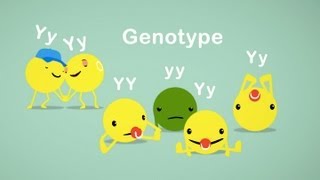(单词翻译:单击)
These days scientists know how you inherit characteristics from your parents.
现如今,科学家们了解到了你是如何从父母那里遗传到各种特征的。
They're able to calculate probabilities of having a specific trait or getting a genetic disease
他们能够计算拥有具体特征或者患有遗传病的机率,
according to the information from the parents and the family history. But how is this possible?
通过他们从父母或家族史得到的信息。但这是如何成为可能的呢?
To understand how traits pass from one living being to its descendants,
为了理解特征如何从一个生物遗传到它的后代,
we need to go back in time to the 19th century and a man named Gregor Mendel.
我们需要回溯到19世纪,去看一个叫乔治·孟德尔的人。
Mendel was an Austrian monk and biologist who loved to work with plants.
孟德尔曾是一个奥地利的修道士,也是一个喜欢研究植物的生物学家。
By breeding the pea plants, he was growing in the monastery's garden, he discovered the principles that rule heredity.
通过他在修道院的花园培育豌豆的经历,他发现了规定遗传的定律。
In one of most classic examples,
在一个最为经典的例子当中,
Mendel combined a purebred yellow-seeded plant with a purebred green-seeded plant, and he got only yellow seeds.
孟德尔将一株纯种的黄粒植株和一株纯种的绿粒植株进行了杂交,最终他只得到了黄色的种子。
He called the yellow-colored trait the dominant one, because it was expressed in all the new seeds.
他把这个黄色特征称为显性特征,因为所有的新种子当中都表现出了这个特征。
Then he let the new yellow-seeded hybrid plants self-fertilize.
然后他让这个新的黄色杂种植株自交。
And in this second generation, he got both yellow and green seeds,
在第二代中,他得到了黄色和绿色的种子,
which meant the green trait had been hidden by the dominant yellow.
这意味着绿色特征曾被显性特征黄色所掩盖。
He called this hidden trait the recessive trait.
他称这个被掩盖的特征为隐性特征。
From those results, Mendel inferred that each trait depends on a pair of factors,
通过那些结果,孟德尔推断每一种特征取决于一对因素,
one of them coming from the mother and the other from the father.
其中一个因素来自于母亲,另一个来自于父亲。
Now we know that these factors are called alleles and represent the different variations of a gene.
现在我们知道了这些因素被称作等位基因,并且表现了一个基因的不同变化。
Depending on which type of allele Mendel found in each seed,
根据孟德尔在每一个种子中发现的等位基因,
we can have what we call a homozygous pea, where both alleles are identical,
当两个等位基因相同时,我们能够得到我们称作纯合子的豌豆,
and what we call a heterozygous pea, when the two alleles are different.
而当两个等位基因不同时,我们便称这种豌豆为杂合子。

This combination of alleles is known as genotype and its result, being yellow or green, is called phenotype.
这种等位基因的组合被称为是遗传型,而它的结果,黄色或绿色,则被称为表现型。
To clearly visualize how alleles are distributed amongst descendants, we can a diagram called the Punnett square.
为了清晰地观察等位基因是如何在后代当中分布的,我们可以使用一个叫庞氏表的图表。
You place the different alleles on both axes and then figure out the possible combinations.
你可以把不同的等位基因放置于两个坐标轴当中,然后计算出可能的组合。
Let's look at Mendel's peas, for example.
让我们以孟德尔的豌豆为例。
Let's write the dominant yellow allele as an uppercase "Y"
让我们把显性黄色等位基因写成大写的“Y”
and the recessive green allele as a lowercase "y."
隐性绿色等位基因写成小写的“y”。
The uppercase Y always overpowers his lowercase friend,
大写的“Y”总是能够主宰小写的“y”,
so the only time you get green babies is if you have lowercase Y's.
所以你得到绿色种子唯一的机会是当你有两个“y”的等位基因时。
In Mendel's first generation, the yellow homozygous pea mom will give each pea kid a yellow-dominant allele,
在孟德尔实验的第一代当中,妈妈,即黄色纯合子豌豆,将会给每一个豌豆宝宝一个黄色的显性等位基因,
and the green homozygous pea dad will give a green-recessive allele.
而爸爸,即绿色纯合子豌豆,将会提供一个绿色隐性等位基因。
So all the pea kids will be yellow heterozygous.
所以,所有的豌豆宝宝都是黄色杂合子豌豆。
Then, in the second generation, where the two heterozygous kids marry,
然后,在第二代,两个杂合子宝宝结合,
their babies could have any of the three possible genotypes,
他们的孩子们可以拥有任意一种上述的三种可能基因型,
showing the two possible phenotypes in a three-to-one proportion.
并以三比一的比例来展现两种可能的表现型。
But even peas have a lot of characteristics.
但即使是豌豆也有许多特性。
For example, besides being yellow or green, peas may be round or wrinkled.
举例来说,除了黄色或绿色,豌豆还可以是园粒或皱粒。
So we could have all these possible combinations:
所以我们可以拥有所有这些可能的组合:
round yellow peas, round green peas, wrinkled yellow peas, wrinkled green peas.
黄色圆粒豌豆,绿色圆粒豌豆,黄色皱粒豌豆和绿色皱粒豌豆。
To calculate the proportions for each genotype and phenotype, we can use a Punnett square too.
为了计算每种基因型和表现型的比例,你同样可以使用庞氏表。
Of course, this will make it a little more complex.
当然,这会使它变得稍微复杂些。
And lots of things are more complicated than peas, like, say, people.
还有许多东西比豌豆更复杂,比方说人类。
These days, scientists know a lot more about genetics and heredity.
目前,关于基因和遗传,科学家们已经了解了更多。
And there are many other ways in which some characteristics are inherited.
并且有许多其他的方法将一些特性继承下去。
But, it all started with Mendel and his peas.
但是,所有的一切都是起源于孟德尔和他的豌豆。


